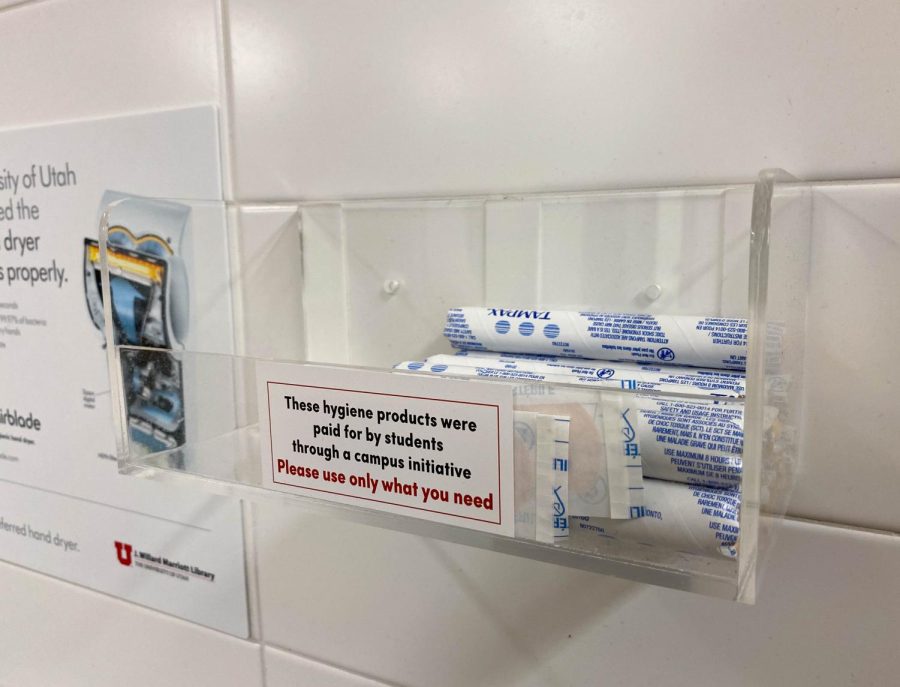Past, Present and Future of the Menstrual Product Initiative at the U
Hygiene product station inside a girl’s restroom at the University of Utah campus in Salt Lake City on Monday, Feb. 20, 2023. (Photo by Andrea Oltra | The Daily Utah Chronicle)
April 19, 2023
When Muskan Walia walked into a women’s restroom at the University of Utah in early 2020, she noticed some period products sitting in a small basket on the counter. She breathed a sigh of relief, knowing that if she needed hygiene products, they were there for her.
But those products in restrooms were few and far between, so Walia, now a third-year student studying philosophy and math, decided to take matters into her own hands to get menstrual products in bathrooms around campus, hoping to give others the security of having them when needed.
Twenty-three percent of students struggle to afford essential hygiene products, according to an ASUU Instagram post. “Knowing these products are available is one less worry for a U student in need,” the post reads.
The products and supplies are funded through a student initiative with money from an ASUU surplus, Walia said in an email interview. A pilot program was introduced in early 2022 for a couple of months to see the interest and if stocking supplies was feasible — and it was.
The official program began in July 2022, right in time for the start of the semester. The budget that was put forth consisted of $25,000, which was used to buy products needed for the 2022-23 school year.
As an ASUU senator, Walia drafted an official bill in early 2022, which was then presented to the ASUU president at the time, Jess Wojciechowski. According to the ASUU website, the cost of providing the products is “minuscule” compared to the benefit and, overall, is significantly less than the cost of toilet paper.
Something that had to be considered was the staff who would be stocking the bathrooms from day to day.
“I think we get into a sort of rhythm of just making decisions,” Walia said. “And it’s like, ‘How do those decisions impact people on the ground that are actually going to be executing it?’ It was so cool to go and talk to the like custodial staff that will be stocking every day. I could buy all the products in the world, but I can’t stock them every day.”
Since then, the menstrual product initiative has been implemented in 1,300 restrooms around campus, which includes academic and athletic spaces. The products are found in women’s, men’s and gender-neutral restrooms. A big part of this initiative was aspiring to create more of a sense of inclusivity and recognition for trans and intersex members of the U.
“It was just like a silent like, you know, ‘We see you and we know you’re on our campus and we’re gonna just care for you in the slightest ways that we can and not make it a big deal,’ because it doesn’t have to be a big deal,” Walia said.
A couple of different products can be found in the small bins that are located in each bathroom. The acrylic containers are either hung on the wall or placed on the counter near the sinks. Products that can be found include cardboard tubed tampons, panty liners, Band-Aids and Maxi-Liners. On each of these bins is a sign stating, “These hygiene products were paid for by students through a campus initiative. Please use only what you need.”
A road bump that came with implementing the initiative, Walia said, was getting products outside of the “normal” places menstrual products can be found. She said there have been times products have been thrown, unused, in the trash in the men’s restrooms.
In the end, the team making the initiative happen chose to go a positive response route by trying to educate those who were pushing back.
According to Walia, the Menstrual Products Program is historic in the state of Utah.
“We are the first public university to have menstrual products in every single men’s, women’s and gender-neutral bathrooms in Utah,” Walia said.
Sharlene Baltazar is a second-year student at the U studying pre-nursing, and she said she has used the products when in a pinch.
“I think it’s a great idea especially since I used it in a time of emergency,” Baltazar said. “It was interesting how makeshift it is, but I mean, it works — which is all I needed.”
Going forward, Walia is looking to incorporate these products in student dormitories as well as academic research buildings. Anticipated maintenance costs going forward will amount to around $15,000 per year.









